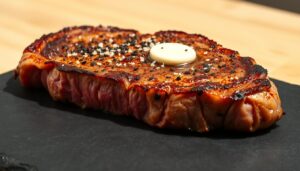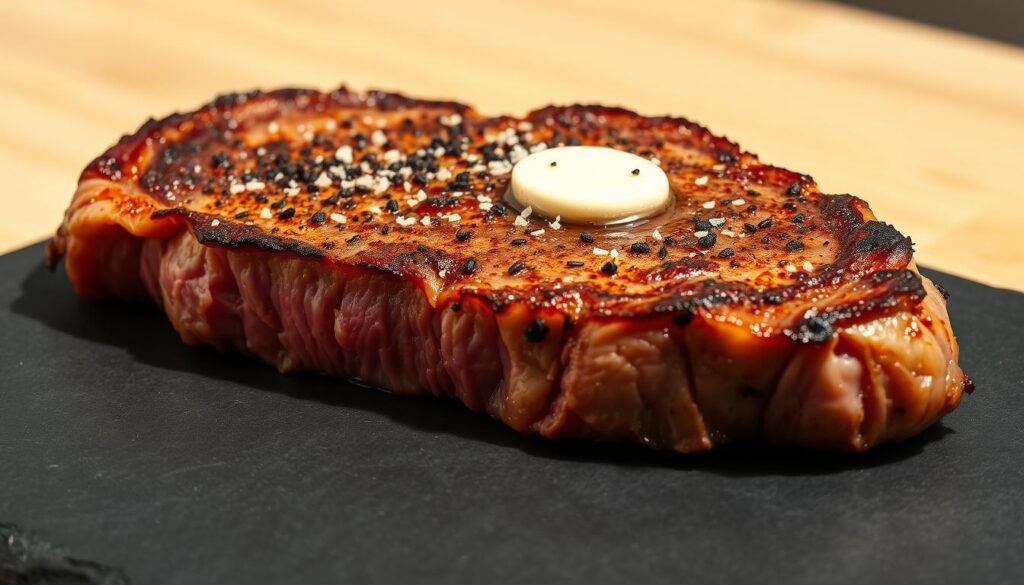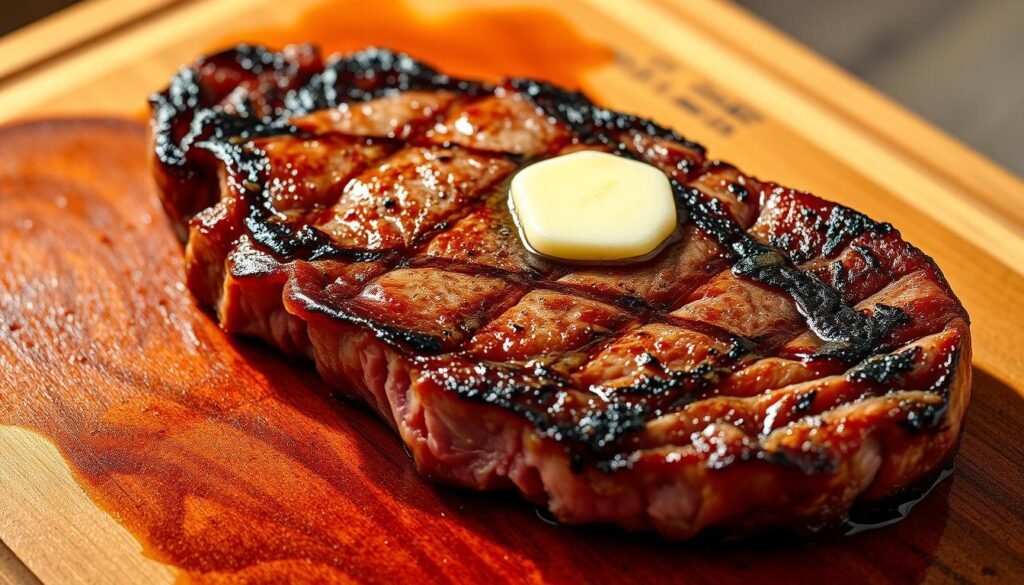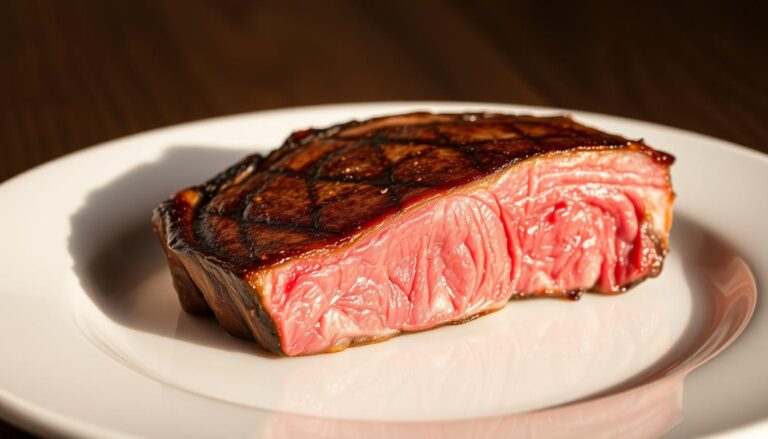The Best Fluffy Pancakes recipe you will fall in love with. Full of tips and tricks to help you make the best pancakes.

Imagine biting into a tender and juicy steak, with a rich, brown crust outside. This is what the reverse sear steak method can give you. It’s a technique that’s become popular for its ability to make steaks consistently great. Using the singer method, you can make a steak that will wow anyone.
The reverse sear method cooks the steak in a low-temperature oven or grill first. Then, it’s finished with a high-heat sear. This way, the steak cooks more evenly and stays tender. You get a juicy inside and a crispy, caramelized crust.
Table of Contents
What Is the Reverse Sear Method?
The reverse sear method is a way to cook steak in two steps. First, it’s slow-roasted at a low temperature, around 250°F or 120°C. Then, it’s finished with a high-heat sear. This method makes the steak tender and juicy.
Understanding the science behind reverse searing is key. The low-temperature phase helps keep the steak’s moisture in. This makes the steak juicy and tender. The final sear, done for 1-2 minutes per side, creates a crust through the Maillard reaction.
Origins of Reverse Searing
Reverse searing has been around for a while but has become more popular lately. It’s known for consistently making high-quality steaks. Chefs and food scientists have experimented with it to get the perfect steak.
Benefits of Reverse Searing
Reverse searing offers a flexible timing window. This makes it easier to get the steak just right. It also makes dining more enjoyable by ensuring steaks are juicy, tender, and perfectly cooked.
Science Behind the Technique
The science of reverse searing involves the Maillard reaction. This reaction happens when food is cooked, creating new flavors and browning. Cooking the steak low first slows down this reaction, leading to even cooking.
To master reverse searing steak, you need to know several factors. These include the steak type, temperature, and cooking time. By understanding these, you can cook a perfect steak every time.
Essential Equipment for the Perfect Reverse Sear Steak
To cook a perfect reverse sear steak, you need the right tools. You’ll need a reliable oven, a skillet or grill for searing, and a thermometer. This ensures you cook at the correct reverse sear steak temperature. A good thermometer is key for a reverse sear steak recipe.
Here are the essential tools you’ll need:
- A cast iron or stainless steel skillet for searing
- A grill for alternative searing methods
- An oven for slow-cooking the steak
- A probe thermometer for continuous temperature readings
- Tongs or a spatula for handling the steak
The right tools make a big difference in cooking your steak. With a few key pieces, you’ll be on your way to a tasty reverse sear steak recipe. Always cook your steak to the correct reverse sear steak temperature for safety and flavor.
| Equipment | Description |
|---|---|
| Oven | For slow-cooking the steak |
| Skillet or Grill | For searing the steak |
| Thermometer | For ensuring correct reverse sear steak temperature |
By following these guidelines and using the right equipment, you’ll create a delicious reverse sear steak recipe. It will quickly become a favorite.
Choosing the Right Cut of Meat
Choosing the right cut of meat is key for the best reverse sear steak method. You need a cut that’s at least 1 to 1.5 inches thick. This thickness ensures even cooking and a nice crust on the outside.
High-quality cuts like ribeye, strip, or filet mignon are ideal. They have the right amount of marbling for flavor and tenderness. It’s important to pick a cut that can handle the heat of the grill or oven.
Best Steak Thickness
The steak’s thickness is crucial for a perfect reverse sear. A too-thin steak cooks too fast, leading to an overcooked outside and undercooked inside. A too-thick steak may not cook evenly, causing raw or undercooked centers.
Recommended Beef Grades
Higher beef grades like Prime or Choice are best. They have more marbling, which means more flavor and tenderness. These grades are perfect for reverse searing.
Popular Cuts for Reverse Searing
Some top cuts for reverse searing are:
- Ribeye
- Strip
- Filet Mignon
These cuts are great for reverse searing. They offer a perfect mix of flavor, tenderness, and texture. By picking the right cut and following the best reverse sear method, you’ll get a steak that’s perfectly cooked with a crispy crust and juicy inside.
| Cut of Meat | Thickness | Beef Grade |
|---|---|---|
| Ribeye | 1-1.5 inches | Prime or Choice |
| Strip | 1-1.5 inches | Prime or Choice |
| Filet Mignon | 1-1.5 inches | Prime or Choice |
Preparation Steps Before Reverse Searing
To get the perfect reverse sear steak, you need to prepare it first. This means tempering and drying the steak before seasoning. Tempering makes the steak cook more evenly, reducing the reverse sear steak time.
Leave your steak at room temperature for about an hour before cooking. This step is key.
Drying the steak with a paper towel is also important. It helps create a better crust during searing. This step is what makes reverse searing different, leading to a tender and juicy steak.
Here are some key steps to follow:
- Salt-brine the steak at least an hour before cooking to enhance flavor and tenderness.
- Pat the steak dry with a paper towel to remove excess moisture.
- Season the steak with your desired seasonings.
By following these steps, you’ll be on your way to a delicious reverse-seared steak. Keep in mind the reverse sear steak time and the benefits of reverse sear vs traditional sear when preparing your steak.
| Steak Thickness | Reverse Sear Steak Time |
|---|---|
| 1 inch | 30 minutes |
| 1.5 inches | 45 minutes |
Temperature Guidelines for Reverse Sear Success
To get a perfect reverse sear steak, knowing the temperature guidelines is key. The reverse sear steak temperature helps you know when your steak is done. It’s all about achieving that perfect reverse sear steak and controlling the temperature is crucial.
Internal temperatures change based on how done you like your steak. For a rare steak, aim for an internal temperature of 120°F after searing. For medium-rare, it’s 130°F. If you prefer your steak medium, it should be 140°F, and medium-well is 150°F. Well-done steak needs to be at least 160°F.
Internal Temperature Chart
| Doneness | Internal Temperature | Oven Temperature | Time in Oven |
|---|---|---|---|
| Rare | 120°F | 105°F | 20-25 minutes |
| Medium-rare | 130°F | 115°F | 25-30 minutes |
| Medium | 140°F | 125°F | 30-35 minutes |
| Medium-well | 150°F | 135°F | 35-40 minutes |
| Well-done | 160°F | 145°F | 40-45 minutes |
By following these temperature guidelines, you’ll easily achieve a perfect reverse sear steak. Always use a meat thermometer to check the steak’s internal temperature. With practice, you’ll master the reverse sear method, impressing everyone with your steaks.
Step-by-Step Reverse Sear Steak Process
To cook a perfect steak with the reverse sear method, start by heating your oven to 250°F (120°C). While it heats up, season your steak and let it sit at room temperature for 30 minutes to 1 hour. This step is key in how to reverse sear steak as it helps the steak cook evenly.
Then, put the steak in the oven and cook for 45 to 90 minutes. The cooking time depends on how you want your steak. Use a wireless meat thermometer to check the steak’s internal temperature.
After cooking, take the steak out of the oven and let it rest for 5 to 10 minutes. This resting time is crucial for the juices to spread, making the steak tender and flavorful. Then, raise the oven temperature to 500°F (260°C) and sear the steak in a hot skillet for 1 to 2 minutes on each side. This final step adds a nice crust to the steak while keeping it juicy inside.

- Cooking the steak at a low temperature to minimize moisture loss
- Using a wireless meat thermometer to monitor the internal temperature
- Letting the steak rest for 5 to 10 minutes after cooking to redistribute the juices
- Searing the steak at a high temperature to create a nice crust on the outside
By following these steps and tips, you can make a delicious and tender steak using the reverse sear method. Always use a reverse sear steak recipe that includes the steps for how to reverse sear steak to get the best results.
Mastering the Final Sear
When it comes to the perfect final sear, you have two main options: reverse sear steak oven vs grill. Both can lead to amazing results. The secret to success is in the technique, especially temperature control and timing.
To get the best reverse sear steak method, aim for a high-temperature sear. This creates a caramelized crust. Use a hot pan or grill for this. The ideal temperature is between 500°F to 600°F. Searing time per side should be about 1 to 2 minutes.
- Using a thermometer to ensure the optimal internal temperature
- Not overcrowding the pan or grill to prevent steaming instead of searing
- Letting the steak rest for 5 to 10 minutes after searing to allow juices to redistribute
By following these tips, you can master the final search. This will give you a reverse sear steak oven vs grill that’s tender and flavorful. With practice, you’ll enjoy a delicious, restaurant-quality steak at home.
Resting and Serving Your Reverse Seared Steak
After cooking your reverse sear steak to perfection, let it rest before serving. This step helps the juices spread out, making the steak tender and juicy. For a perfect reverse sear steak, rest it for at least 10 minutes after baking and 5 minutes after searing.
Here are some tips to make your reverse sear steak even better:
- Use a sharp knife to slice the steak against the grain.
- Serve with your favorite sides, such as roasted vegetables or mashed potatoes.
- Consider adding a sauce, like a cabernet reduction, to complement the flavors of the steak.
The secret to a great reverse sear steak is to cook it gently and patiently. This way, the steak can reach its full potential. By following these tips and using the reverse sear method, you’ll get a tender, juicy, and flavorful steak that will impress everyone.
Troubleshooting Your Reverse Sear Method
Trying to cook a perfect reverse sear steak can sometimes go wrong. We’ve listed common problems and how to fix them.
Common Problems
Issues like overcooking, undercooking, and uneven cooking can happen. These problems might come from wrong oven temperature, not enough searing time, or too thin steak.
Quick Solutions
Here are quick fixes for these issues:
- Use a thermometer to check the oven temperature. Adjust it to keep it between 200°F to 300°F for slow cooking.
- Try searing for 1-2 minutes on each side. Make sure the grill or skillet is very hot before searing.
- Choose a steak that’s at least 1.5 to 2 inches thick. This helps with even cooking and a nice crust.
By following these tips, you can get a perfectly cooked steak. It should be tender inside and crispy outside. Always use high-quality steak cuts like ribeye or tenderloin. Cook it to the right internal temperature for your doneness preference.

| Steak Thickness | Internal Temperature | Cooking Time |
|---|---|---|
| 1.5-2 inches | 130°F-135°F | 45-55 minutes |
| 1-1.5 inches | 120°F-125°F | 35-45 minutes |
With practice, you’ll get better at cooking a perfect reverse sear steak. You’ll enjoy delicious meals with your loved ones.
Reverse Sear vs. Traditional Steak Cooking Methods
When cooking steak, you can choose between reverse sear and traditional sear. The reverse sear method involves slow-roasting the steak at a low temperature, around 250°F (120°C). Then, you sear it at a high temperature. This method gives you more time to cook the steak to your liking, making it easier than traditional methods.
Traditional steak cooking can lead to overcooked edges and raw centers. The reverse sear method helps avoid these problems, making the steak cook more evenly. To get the best results, use a meat thermometer. Aim for an internal temperature of 120-125°F (49-52°C) for rare, 130-135°F (54-57°C) for medium rare, and 140-145°F (60-63°C) for medium.
The reverse sear is great for thicker steak cuts like ribeye or strip steak. These cuts are tender and flavorful because of their marbling. Bone-in cuts like T-bone or porterhouse also cook better, thanks to the bone helping to distribute heat evenly. This method ensures your steak is crispy on the outside and juicy on the inside, making it a favorite among steak lovers.
- A more forgiving cooking option with a larger time window for reaching the desired doneness
- Reduced risk of overcooked edges and raw centers
- Improved tenderness and flavor due to the use of thicker cuts with ample marbling
- Enhanced cooking consistency with bone-in cuts
Choosing the reverse sear method can elevate your steak cooking. It allows you to achieve a perfectly cooked steak with ease and precision. This makes it the top choice for many steak enthusiasts.
Advanced Tips for Restaurant-Quality Results
To get a perfect reverse sear steak, focus on seasoning, timing, and techniques. A well-seasoned steak boosts flavors. Precise timing ensures the steak is cooked just right. Use a wireless meat thermometer for the best results.
Some key tips for advanced reverse sear steak cooking include:
- Let the steak come to room temperature before cooking
- Using a clean grill or oven to achieve even cooking
- Not overcrowding the grill or oven to ensure proper air circulation
- Slicing the steak against the grain for optimal tenderness
By following these advanced tips and using a reliable reverse-sear steak recipe, you can achieve restaurant-quality results at home. Always use a meat thermometer to ensure the perfect internal temperature. Don’t be afraid to experiment with different seasonings and techniques to find your perfect reverse sear steak.
| Steak Type | Internal Temperature | Resting Time |
|---|---|---|
| Tomahawk | 48-49°C | 10-15 minutes |
| Ribeye | 49-50°C | 10-15 minutes |
| Filet Mignon | 51-52°C | 5-10 minutes |
Conclusion
The reverse sear method is a game-changer for steak lovers. It makes steaks tender, juicy, and full of flavor. By cooking the steak slowly before searing, you get an amazing taste.
Try different cuts and cooking ways to find what you like best. With practice, you’ll impress everyone with your steak skills. So, get ready to make the best steak ever.
FAQ
What is the reverse sear method?
The reverse sear method is a cooking technique. It starts by slowly roasting the steak in the oven. Then, it finishes with a high-heat sear. This method makes the steak tender, and juicy, and has a delicious crust.
What are the benefits of the reverse sear method?
This method has many advantages. It ensures even doneness and better temperature control. It also creates a superior crust. Plus, it helps keep more of the steak’s natural juices and flavor.
What equipment do I need for the perfect reverse sear steak?
You’ll need an oven, a heavy-duty skillet or grill, and a meat thermometer. A cast-iron skillet or a hot grill is best for the final sear.
What’s the best cut of meat for reverse searing?
Thicker cuts like ribeye, strip loin, or filet mignon work best. They should be about 1 to 2 inches thick for even cooking.
What are the crucial preparation steps for reverse searing?
Before you start, let the steak come to room temperature. Then, pat it dry thoroughly. This ensures a perfect sear and even cooking.
How do I control the temperature for the reverse sear process?
Controlling temperature is key. Monitor the steak’s internal temperature during oven roasting. Then, sear it at high temperature for the final step.
How do I properly sear the steak after the reverse sear?
Sear the steak quickly and evenly in a hot skillet or on a high-heat grill. This step is crucial for the perfect crust.
How do I know when my reverse sear steak is done?
Check the steak’s internal temperature. Remove it when it’s 5-10°F below your desired doneness. The temperature will rise during the resting period.
What are some common problems with the reverse sear method and how can I fix them?
Issues like uneven cooking and a lack of sear can happen. To fix them, adjust oven temperatures and searing techniques. Also, keep a close eye on the internal temperature.
How does the reverse sear method compare to traditional steak cooking?
The reverse sear method offers better temperature control and moisture retention. It also creates a superior crust. However, it takes more time and preparation than traditional methods.









